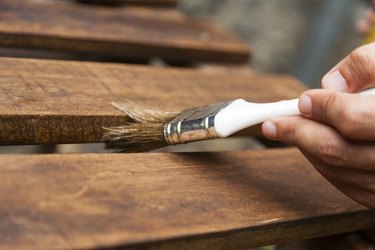
You might not have ever considered adding tint to polyurethane, but it's an effective way to make a semitransparent topcoat for furniture, woodwork and floors. It's an especially useful technique for adding ultraviolet protection to exterior woodwork without actually painting it. You can use the same universal coloring pigments that are used for coloring paint; these are available in tubes at paint and hardware stores. It will take some trial and error to get the color you want -- you won't find a formula anywhere -- so prepare a test surface for experimentation.
Step 1
Stir the polyurethane thoroughly. You can tint both oil- and water-based products with universal coloring pigments.
Video of the Day
Step 2
Measure a small amount of polyurethane by pouring it in a measuring cup, then transfer it to another container. This is your test batch, so make the quantity an easy-to-manage fraction of the whole. For example, if you want to tint a quart, you might pour out about 3 ounces, which is about one-tenth of a quart.
Step 3
Choose a pigment color. If you're aiming for a wood tone, you'll have five choices: burnt umber, raw umber, burnt sienna, raw sienna and black. You can use any color you like, however.
Step 4
Add the pigment to the test batch of polyurethane drop by drop, counting the number of drops you put in. Stir thoroughly with a stir stick until the pigment is uniformly distributed. Combine as many colors as desired in this way, keeping track of how many drops of each you use.
Step 5
Test the color by painting it on a scrap piece of wood. Add more color as needed. If the color is too dark or the tint wrong, discard the test batch and start over with fresh polyurethane.
Step 6
Multiply the number of drops of each pigment you used to make a color you like by the appropriate factor. For example, if you measured out one-tenth of a quart, nine-tenths are left in the container, so you need to multiply by nine to get the same color in the container.
Step 7
Mix the main batch in the same way that you mixed the test batch. Add the pigments, counting the drops you put in, then stir thoroughly until they are evenly distributed.
Video of the Day